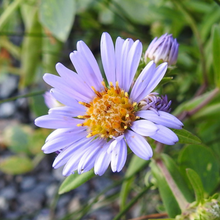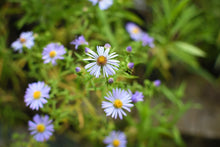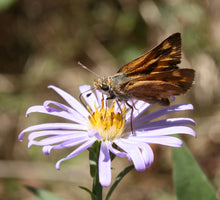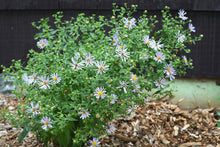
Symphyotrichum subspicatum / Aster subspicatum
Douglas Aster’s purple daisy-like flowers put on a show in the pollinator garden in late summer through autumn when most other flowers have long since gone to seed. Rugged, fast-growing and often quite tall, add them to an open area where a swath can form for a sea of purple flowers for native bees and butterflies to dine on late in the season.
- Plant type/canopy layer: deciduous perennial herbaceous plant
- Size at maturity: 1-4' tall, 2' wide
- Light requirements: full sun to partial shade
- Moisture requirements: prefers moist soil, but will tolerate a wide range of soils
- Growth rate/ease: fast growing, easy to grow
- Bloom time: June - October (August - September in the Portland Metro area)
- Wildlife support: flowers attract and provide nectar to hummingbirds, adult butterflies, bees and other insect pollinators; overall plant attracts and support beneficial and other pest eating insects and is a caterpillar host plant and larval food source
- Native habitat/range: locally common in disturbed areas, on beaches and other open moist sites and along streams at low elevations across Western North America from Alaska to Northern California. Portland Plant List – yes.
- Special features & uses: beneficial insect, pollinator and wildlife favorite, especially in the late season; landscape uses include pollinator gardens, meadowscapes, rock gardens and erosion control; drought tolerant
Gardening with Douglas Aster: Hardy, easy to grow - an excellent addition for open sunny wildflower meadows, and important late season blooms for providing plenty of nectar and pollen for pollinators late in the summer and into autumn. Form can be quite variable depending on soil quality and sunlight, from shorter and compact to very tall and leggy. Bloom color can also vary widely from pale violet in shady areas to dark purple in full sun. Plant in an area where it will have plenty of room to spread to create a dense swath of greenery and blooms. It spreads vigorously by rhizome and seed. Over time, you’ll have a lot to share with friends. The spent flowers stay upright on sturdy stalks and, if left, can provide winter interest and habitat resources for birds and overwintering beneficial insects.
Photo Credit 1: "Symphyotrichum subspicatum" by gertjanvannoord is licensed under CC BY-ND 2.0
Photo Credit 2 & 4: Tara Lemezis
Photo Credit 3: "Woodland Skipper Butterfly" by born1945 is licensed under CC BY 2.0







